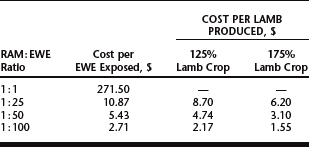CHAPTER 85 Breeding Soundness Evaluation and Surgical Sterilization of the Ram
Breeding soundness evaluation (BSE) is an overall assessment of the ram’s capacity for serving and impregnating a number of ewes during a breeding season. An overall physical examination is performed with special emphasis on the reproductive system. The BSE includes anatomic and structural correctness, freedom of disease, body condition, scrotal circumference, and semen quality. The ram accounts for the major genetic changes in a flock. An economic soundness evaluation (ESE) is an assessment of the ram’s potential contribution to the profitability of a sheep enterprise. An ESE includes an evaluation of ram management and an assessment of the potential genetic contribution of the ram.
ECONOMIC SOUNDNESS EVALUATION
The ram genotype influences not only the quality but also the quantity of production per ewe exposed. A highly fertile ram can increase lamb crops by impregnating more ewes and by producing more multiple births per ewe.1 Research has shown that over three generations the ram is responsible for approximately 87.5% of the genetic influence on a flock.2 Therefore, specific criteria should be established for both production and reproductive traits.
Heritability
The estimated heritability of different traits varies greatly. Although many production traits, such as carcass, dairy, and wool characteristics, are highly heritable, most reproductive traits are not (Table 85-1).3 Selection pressure for traits with low heritabilities must be intense over several generations for progress to be noted. Genetic progress is generally slower when selecting for multiple traits. It is also important to be aware that selection for some traits may have a negative impact on others. For example, many carcass characteristics and wool characteristics are negatively heritable.
Table 85-1 Heritability Estimates
| Trait | Heritability (%) |
|---|---|
| Reproductive | |
| Ewe fertility | 5 |
| Prolificacy | 10 |
| Scrotal circumference | 35 |
| Age at puberty | 25 |
| Carcass | |
| Carcass weight | 35 |
| Weight of trimmed retail cuts | 45 |
| Percent trimmed retail cuts | 40 |
| Loin eye area | 50 |
| Fleece | |
| Grease fleece weight | 35 |
| Clean fleece weight | 25 |
| Percent yield | 40 |
| Staple length | 55 |
| Fiber diameter | 40 |
Cost of Ram Power
The cost of ram power per lamb produced is an important component of the ESE. The cost of ram power is determined by purchase price and by the number of lambs sired by an individual ram. Table 85-2 gives an example of annual costs per ram, exclusive of purchase price. Based on this example, Table 85-3 shows how the ram-to-ewe ratio and lambing percentage affect the annual cost of a ram per lamb produced.
| Example Purchase Price $350.00 | |
| Fixed Costs | |
| Depreciation/3y | 117.00 |
| Interest on investment at 12% | 42.00 |
| Total Fixed Cost | $159.00 |
| Variable Costs | |
| Feed and maintenance | 60.00 |
| Overhead | 5.00 |
| BSE | 15.00 |
| Death loss/15% | 52.50 |
| Total Variable Costs | 132.50 |
| Total Costs | 291.50 |
| Income from Wool | 20.00 |
| Annual Cost per Ram (exclusive of purchase price) | 271.50 |
* These figures are representative of Colorado producers as reported by CSU farm management specialists Rod Sharp and Paul Gutierrez.
Breeding Capacity
The breeding capacity of a ram is determined by sperm production, semen quality, and libido. The breeding capacity of a highly fertile ram is one of the most difficult concepts for many sheep producers to accept. Under most range and semiconfinement conditions, a ram in good physical condition, with high libido, can successfully serve 100 or more ewes during a 17-day breeding cycle. For example, one 5200-ewe western range operation using 1.5 rams per 100 ewes consistently lambs over 90% of the bred ewes during the first 17 days of the lambing period and averages a 140% lamb crop.4 In this type of an operation, a higher ram-to-ewe ratio cannot be economically justified.
BREEDING SOUNDNESS EXAMINATION
The BSE is one of the most essential components of the overall economic soundness of a sheep operation. Reproductive efficiency is a key element of economic efficiency.
Brucella ovis
The B. ovis organism enters the blood through the mucous membranes and infects the reproductive tract. Clinical signs include enlargement and fibrosis of the epididymis with wasting of testicular tissue. In some cases, infection of the secondary sex organs occurs without involvement of the epididymis. In these instances, no palpable lesions are evident, and diagnosis must be made by microscopic examination of the semen, semen culture, or serology. Table 85-4 shows a comparison between the semen qualities of a B. ovis–free and a B. ovis–infected ram population.
Table 85-4 Semen Quality of a Brucella Ovis-Free and a Brucella Ovis-Infected Ram Flock
| B. Ovis-Free | B. Ovis-Infected | |
|---|---|---|
| Rams, n | 84 | 94 |
| B. ovis ELISA positive, n | 0 | 72 |
| Grossly palpable epididymal lesions, n | 0 | 23† |
| Motility, % | 66 | 29 |
| Semen parameters, mean | ||
| Normal sperm, % | 86.5 | 55.5 |
| Detached heads, %* | 6.9 | 25.5 |
* In an infected population, B. ovis infection is correlated with seminal leukocytes and detached spermatozoal heads.
† Removed without semen evaluation.
Data from Ram Breeding Soundness Evaluation Records, Fort Collins, CO: Department of Clinical Sciences, Colorado State University, 1990.
Stay updated, free articles. Join our Telegram channel

Full access? Get Clinical Tree



